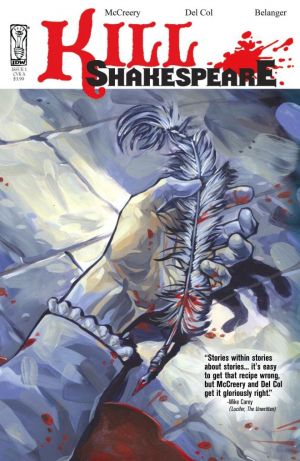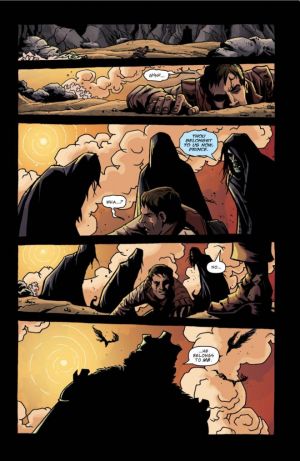Kill Shakespeare #1
By Andy Frisk
April 21, 2010 - 20:34
IDW Publishing
Writer(s): Conor McCreery and Anthony Del Col
Penciller(s): Andy Belanger
Colourist(s): Ian Herring
Letterer(s): Robbie Robbins
$3.99 US
With titles like Fables and The Unwritten skillfully playing with the creative boundaries between fiction, reality, and meta-fiction, it seemed inevitable that the greatest storyteller of all time (or as he is referred to in Neil Gaiman’s legendary Sandman series, the “willing vehicle for the great stories”), William Shakespeare, would have his characters and plots loosely adapted to a free form narrative where they are liberated from their contexts and plays of origin. Kill Shakespeare (sounds like a Quentin Tarantino film) attempts to do just that. Hamlet, while on his way from Denmark to England, where he is being forced to live in exile for killing Polonius (if you’ve never read Hamlet before then you’re undoubtedly lost already) is attacked by pirates on the high seas and his travel companions, Rosencrantz and Guildenstern (who are meant to assassinate him in the play) become his friends and comrades in arms. Unfortunately, Rosencrantz and Guildenstern still end up dead, and Hamlet is swept overboard. He washes up on a beach and is recruited by Richard III in order to aid him in his battle against the “wizard” Shakespeare who holds them all in “tyranny…” (Richard III is another of Shakespeare’s characters for those not familiar, and he’s definitely not a good guy…)
 |
Shakespeare’s works have been adapted into comic book form, and he has appeared as himself in comic books (most notably and masterfully in the aforementioned Sandman series), but his characters, freed from their plays, have not. This whole concept seems like a fascinating idea, but somehow doesn’t seem to be nearly as fascinating in execution. Honestly, Shakespeare’s characters and their stories are so complex and literary themselves that taking them out of their stories and contexts seems unnecessary, but might prove to be worthwhile if done right. Unfortunately, the whole idea of fables, fairy tale characters, and the like existing outside of their tales of origin and developing on their own at this point simply comes off as trite. In order to make yet another storyline along these lines work, it would have to be something hitherto unseen and really engaging. Kill Shakespeare #1, again unfortunately, is not.
I really want this series to work. I love Shakespeare’s plays and one of my all time favorite comic book single issues of all time is Sandman #19 “A Midsummer Night’s Dream” (“A Midsummer Night’s Dream” is also my favorite of Shakespeare’s comedies). Neil Gaiman made great use of the character Puck throughout his legendary series, and in issue #19 in particular, Gaiman explored the nature of story and storytelling in a way rarely done as masterfully in any genre. Kill Shakespeare looks to attempt something of the like, but fails (at least thus far, and it’s not far along yet so there is hope), because unlike Gaiman, McCreery and Del Col don’t capture the nature of the characters they decide to use from Shakespeare’s canon. Hamlet doesn’t seem as tortured and is way more active and decisive that he is in Hamlet (some Shakespearean scholars would undoubtedly disagree with me here), and the change in Rosencrantz and Guildenstern’s nature is wholly uncharacteristic. McCreery and Del Col do plan to strike out in their own direction though, and definitely do so with these changes.
By doing so they run the risk of accomplishing what their characters plan to do. McCreery and Del Col are killing Shakespeare figuratively. Beyond being named after and looking like characters from Shakespeare’s plays, the protagonists of Kill Shakespeare, as stated, don’t really behave like their inspirations. This effectively “kills” them as being Shakespeare’s. Obviously, this is a comic book and not a literary magazine or an adaptation of one of The Bard’s plays, but unlike Gaiman’s use of Shakespearean characters and material, Kill Shakespeare is less relevant and does little to enhance an appreciation of Shakespeare’s works. Admittedly though, it does draw attention to The Bard’s works in a location rarely known to draw attention to The Bard himself, the local comic shop.
 |
One aspect of Kill Shakespeare that does succeed quite well is Andy Belanger’s artwork. His work is vaguely reminiscent of Mike Mignola’s, but is more proportionate and realistic looking. Belanger particularly excels in setting the gothic atmosphere and capturing the shadowy and frantic motion of his supernatural interlopers. Ian Herring’s colors complete the effect and the blood red sky which hangs oppressively over Hamlet’s ship as it is attacked by pirates is really striking without being overbearing or unnatural to the context of the scene.
Again, I really want to see this series work, but as a former scholar myself, I can’t really seem to get into such a powerful corruption of the most powerful stories ever told. Undoubtedly, McCreery and Del Col know their Shakespeare, but they don’t seem to feel it, at least not yet…
Rating: 5/10
Related Articles:
Abridged Classics book review
Native American Classics Review
Robert Louis Stevenson Returns in Graphic Classics
Fantagraphics Offers Classics for Free Comic Book Day 2012
More Literary Classics Juliet and Dorian Gray Join Bluewater’s Roster
Witchblade - the Complete Series (Anime Classics)
Gungrave the Complete Series Anime Classics
Baltimore Comic-Con Brings the Classics to Charm City
Classics Illustrated Nominated for Eagle Awards!
Classics are Back at BOOM! This January
